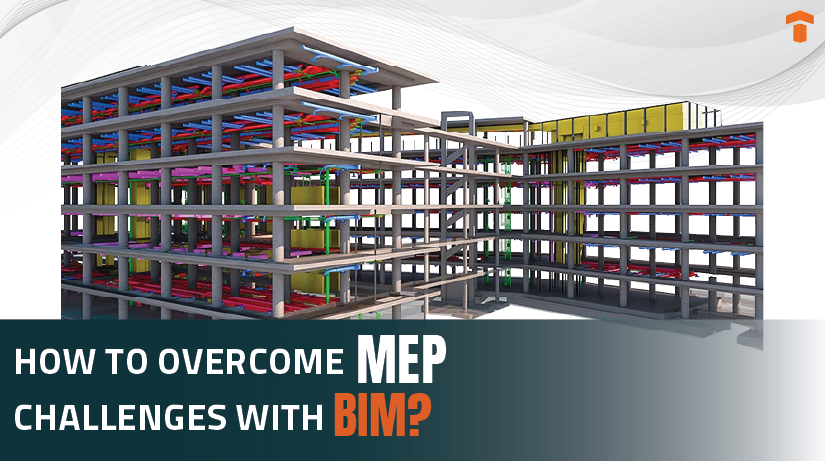How to overcome MEP challenges with BIM
Apr 01, 2024
Category: BIM / Digitization / Automation
Admin

The success of the construction projects depends upon the seamless integration of MEP disciplines. BIM contributes to revolutionizing MEP projects by offering solutions based on real-time clash detection. In this blog, a better explanation of MEP and how BIM can overcome the challenges associated with MEP has been discussed.
Assessing the critical challenges of MEP
Mechanical, Electrical, and Plumbing (MEP) systems traditionally have a lot of challenges. The MEP design includes managing fragmented communication during the project and multidisciplinary design clashes. This has a strong negative impact on finishing the projects on time and increases the budget.
The implementation of BIM in MEP design can lead to better coordination. It can improve the detection of clashes in real time and lead to better spatial design optimization. This will lead to better efficiency in the entire structure.
The significant challenges identified involve:
1) The case of design clashes across several MEP disciplines
The lack of coordination arises across MEP design issues including heating challenges, ventilation hassles, plumbing and fire protection, to name a few of them. These factors cause cost and time constraints, and delays in the project.
2) Lack of cross-team coordination
One of the most crucial elements in MEP management is effective coordination and collaboration. It has often been found that communication challenges lead to misinformation being spread. This, coupled with fragmented data sharing, makes it difficult to maintain a unified platform.
3) Not having complete clarity of spatial concept
One of the most common challenges in MEP design (Mechanical, Electrical, and Plumbing) is insufficient spatial understanding. As a result, stakeholders face complex difficulties involving better visualization. Not comprehending the complex spatial relationships across various MEP design systems is a considerable challenge.
4) Inefficiency associated with the Data Integration Process
Another critical challenge associated with MEP is that of inefficient data integration. These difficulties are mostly encountered during the merging, managing, and data-sharing processes across various systems. Traditional methods lead to problems of errors, data silos, and delays, along with suboptimal system designs.
However, it is important to note that oftentimes the challenges are relative. For example, as MEP considerations encompass aspects like HVAC (Heating, Ventilation and Air Conditioning) a change in any one of HVAC elements can cause the data integration process to become inefficient. It may also lead to design challenges. Thus, it can be stated that the challenges are mostly dependent on certain internal or external factors affecting them.
Contribution of BIM in Managing MEP Challenges
BIM needs to be implemented to efficiently manage the MEP design challenges as it would allow for better coordination. Implementing BIM in MEP courses leads to better cost savings through optimized material usage and streamlining of the construction process.

The ways through which BIM can mitigate MEP course challenges are:
1) Helping in Clash Detection and Resolution
BIM includes clash detection tools in real-time, which are tasked with constantly analyzing 3D models for conflicts. This is to find issues between MEP systems, structural elements, and architectural components.
2) Developing a coordinated BIM model
When it comes to managing coordination challenges, BIM rectifies it by providing a centralized digital platform. It contributes towards outlining a system that can be accessed by all project stakeholders in real-time and get regular updates. The real-time factor also allows multiple teams to collaborate across various projects simultaneously.
3) Offering 3D Visualization
One of the challenges associated with MEP design is the need for more spatial understanding that BIM effectively corrects as it offers 3D visualization. BIM has an intricate system of layouts with a realistic edge. This improves the ability of architects to plan and make informed decisions.
4) Improving the process of Data Integration
The presence of a centralized system in BIM, provides Architects with the advantage of having easy access to data all times. This is supported by the standardized system of data protocols and formats that are present in BIM software. This enables simplification in the transfer and exchange of information and improves data integration.
Conclusion
Thus, BIM effectively addresses the challenges associated with MEP design by developing a coordinated and three-dimensional digital representation of structures. Implementing BIM in the MEP course allows for better optimization and easy clash detection, thereby improving stakeholder collaboration in the projects.
About TechnoStruct Academy
TechnoStruct Academy is the educational arm of TechnoStruct, LLC, a registered design engineering firm based in California. It offers specialized BIM training programs for architecture, MEP, and BIM Management.
Our BIM Certification Courses:
BIM-Ready+: Become a BIM Management professional specialized in managing all ASMEPF projects working with open BIM and interoperability with a credible BIM Manager Certification.
BIM-Ready Complete: Become a BIM Engineer specialized in all ASMEPF (Architectural, Structural, Mechanical, Electrical, Plumbing, and Fire Protection) disciplines working with open BIM and interoperability.
BIM-Ready (Arch+Structure): Specialize in BIM Fundamentals, Conceptual Design, Sustainable Design, Design Development, and Construction Documentation in the BIM Environment with this BIM Architect Course.
BIM-Ready (MEP): Become an MEP BIM Engineer specializing in BIM Fundamentals, HVAC, Electrical, Plumbing and Fire Fighting, Design, and Modeling in a BIM Environment.
Bexel Manager Certification Program: This program teaches you about BEXEL Manager, a software that brings together key 3D, 4D, 5D, and BIM features, making it quick and easy to embrace BIM processes and technology for speedy project implementation.







